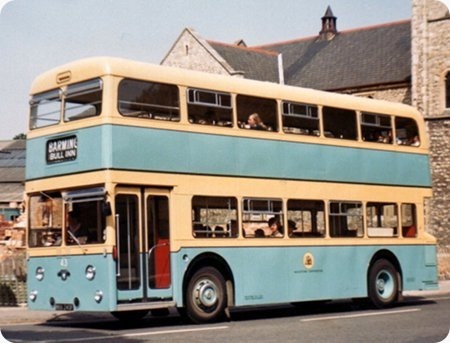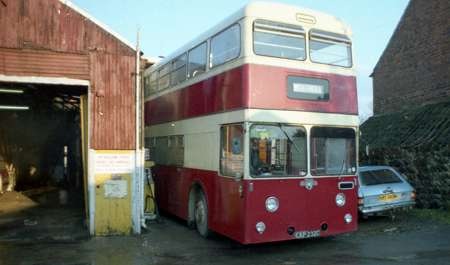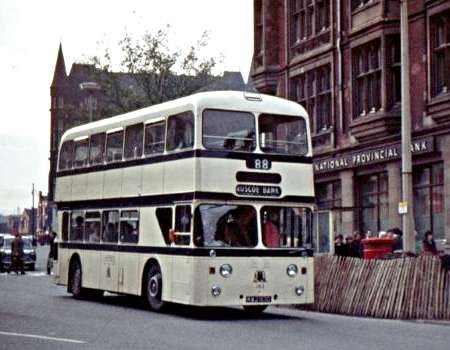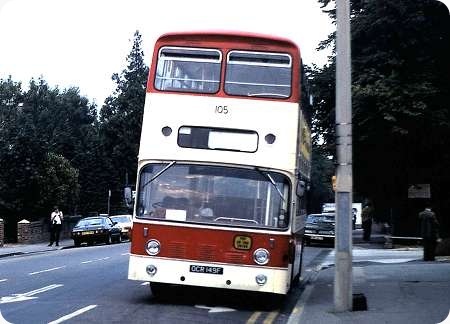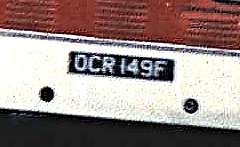Maidstone Corporation – Leyland Atlantean – NKK 243F – 43
Maidstone Corporation
1968
Leyland Atlantean PDR1/1
Massey H43/31F
Maidstone Corporation’s No 43 registration NKK 243F was a rather rare combination of Massey body on the Leyland Atlantean PDR1/1 chassis with H43/31F seating being one of only thirty two rear engine chassis bodied by Massey Bros. Of this total Maidstone Corporation bought twenty all on Atlantean chassis No’s 27-46 and Colchester Corporation bought ten also on Atlantean No’s 45-54, the other two went to members of A1 Services of Ardrossan one on the only Daimler Fleetline chassis bodied by Massey which was followed by one on an Atlantean. All thirty two had the same seating layout as the photo’s subject.
Several of Massey’s regular customers who bought from them on front engine chassis chose not to go to them when rear engines became the order of the day which possibly contributed to the later merger with Northern Counties.
Photograph and Copy contributed by Diesel Dave
20/04/14 – 09:32
By 1968 most bodybuilders were producing bodies with a more shaped frontal aspect on rear engined chassis but to my eye this is quite an attractive functionally boxy body, aided by a simple but effective livery.
Ian Wild
20/04/14 – 17:36
I Worked for Connor & Graham, Easington East Yorkshire in 1982 and we had three of them, I was told he bought two and later the dealer phoned and gave the third one free, the bodywork was very sound as it was used on school run from Sunk Island to Withernsea and to Hull on Saturday, I left in 1983 I think they were Maidstone Corporation Nos 28,29 and 31.
Phil Savin
21/04/14 – 06:22
I agree with Ian, although boxlike, I thought the Massey design was quite attractive and far better looking than some other builders designs where curved or wrap-round windscreens were indiscriminately ‘grafted’ on leaving some real ‘hotch potch’ end results. The livery also helps. Tasteful, traditional and practical.
Philip Halstead
21/04/14 – 06:23
Wigan had at least one AN68. Were there any more – for Wigan or anyone else?
David Oldfield
21/04/14 – 10:49
David
Northern Counties bought Massey Bros in 1967.
The final Massey deliveries to Wigan Corporation were Titans FEK1-9F in early 1968.
The first AN68s delivered to Wigan Corporation were NEK1-10K in August 1972.
Dave Farrier
22/04/14 – 05:04
Ah. Right. Obviously NCME then. Not to a Massey outline by any chance?
David Oldfield
24/04/14 – 08:18
London Country borrowed six of these buses during a period of acute vehicle shortage in 1977. They were operated out of Chelsham Garage on the busy 403 group of services across Croydon to Wallington. I rode on several of these at the time, and noted the high standard of internal finish of the Massey bodies, but the PDR1/1 Atlantean did struggle a bit on the long gradient up to Sanderstead Church. In the mid 1960s, Massey double deck design went from the extremely curvaceous to the excessively angular. The Pemberton firm was very late entering the rear engined double deck bus market, and this application of the perpendicular was its eventual offering. It would seem that, from then on, some structural componentry must have been common to rear engined and front engined double deck bus bodywork, because the latter type, hitherto very rounded, then became very squared up. It was as if the firm had become revitalised by memories of its markedly austere wartime utility designs. The bold angularity of these Atlanteans was not unattractive, but the vertical front screens must have given problems with internal reflections from the interior lighting during hours of darkness. I was never a convert to the insipid and rather grubby pale blue and cream livery. To my eye, the colours do not complement each other – the lighter colour would have looked better had it been white with black lining out – but Maidstone really should never have abandoned in the mid 1960s the magnificent ochre and cream livery that I recall adorning the trolleybuses when I was a child living in Kent during the late 1940s. Maidstone, once a proud operator, seemed to go progressively downhill in its metamorphosis from ‘Corporation’ through ‘Borough Council’ to the ultimate horror of ‘Boro’line’ with its truly ghastly blue and yellow, with red and white trim, so called "livery".
Take a look at this if you don’t believe me. No prizes for guessing the perpetrator of this abominable colour scheme. No wonder the Boro’line outfit eventually went bust. //victoryguy.smugmug.com/Maidstone
Roger Cox
24/04/14 – 08:18
When NCME took over Massey, they moved into the former Massey factory and some subsequent NCME bodies showed a marked Massey influence, particularly around the front of the upper deck. None were identical to past Massey products, however.
Peter Williamson
09/08/17 – 16:58
There is a Leyland Atlantean with Massey body in Northern Ireland which is used as an "activity centre". The vehicle spends most of the year in under cover storage but has re-emerged this summer. It is devoid of any identity but can only be an ex Colchester or Maidstone example. Did any of the C&G ones go to Ireland, or can anyone reveal more about what this vehicle may be.
Bill Headley
20/02/19 – 06:34
Did the identity of the Massey bodied Atlantean in Northern Ireland ever got established? I too liked the Massey bodied examples. They looked different from the Alexander, MCW, Roe, Northern counties etc.There aren’t many left.
Roy Wolstencroft
22/02/19 – 06:25
I have scrutinized Shane Conway’s excellent ‘Classic Irish Buses’ website and have been unable to find any trace of a Massey-bodied Atlantean. As you’ll gather, the site is pretty thorough. www.classicbuses.co.uk/+Leyland
Bill Headley (above) says that the one in Northern Ireland is devoid of any identity, but it must carry a registration plate, if only a Northern Irish one. Perhaps it could be identified from that.
How close is it possible to get to the said vehicle? There is likely to be some source of identification on it, somewhere.
David Call
Quick links to the - Comments Page - Contact Page - Home Page
